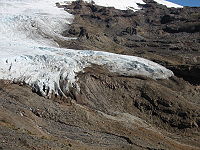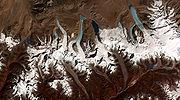
Glacier terminus
Encyclopedia


Glacier
A glacier is a large persistent body of ice that forms where the accumulation of snow exceeds its ablation over many years, often centuries. At least 0.1 km² in area and 50 m thick, but often much larger, a glacier slowly deforms and flows due to stresses induced by its weight...
at any given point in time. Although glaciers seem motionless to the observer, in reality glaciers are in endless motion and the glacier terminus is always either advancing or retreating. The location of the terminus is often directly related to glacier mass balance
Glacier mass balance
Crucial to the survival of a glacier is its mass balance, the difference between accumulation and ablation . Climate change may cause variations in both temperature and snowfall, causing changes in mass balance. Changes in mass balance control a glacier's long term behavior and is the most...
, which is based on the amount of snowfall which occurs in the accumulation zone
Accumulation zone
On a glacier, the accumulation zone is the area above the firn line, where snowfall accumulates and exceeds the losses from ablation, . The annual Glacier equilibrium line separates the accumulation and ablation zone annually...
of a glacier, as compared to the amount that is melted in the ablation zone
Ablation zone
Ablation zone refers to the low altitude area of a glacier or ice sheet where there is a net loss in ice mass due to melting, sublimation, evaporation, or calving. The ablation zone is delineated by the equilibrium line altitude , or snow line, which separates the ablation zone and the high...
. The position of a glacier terminus is also impacted by localized or regional temperature change over time.
Tracking
Tracking the change in location of a glacier terminus is a method of monitoring a glacier's movement. The end of the glacier terminus is measured from a fixed position in neighboring bedrockBedrock
In stratigraphy, bedrock is the native consolidated rock underlying the surface of a terrestrial planet, usually the Earth. Above the bedrock is usually an area of broken and weathered unconsolidated rock in the basal subsoil...
periodically over time. The difference in location of a glacier terminus as measured from this fixed position at different time intervals provides a record of the glacier's change. A similar way of tracking glacier change is comparing photographs of the glacier's position at different times.
The form of a glacier terminus is determined by many factors. If the glacier is retreating, it is usually mildly sloping in form because a melting glacier tends to assume this shape. But there are many conditions that alter this typical shape, including the presence of thermal fields and various stresses that cause cracking and melting feedback resulting in glacial calving and other diverse forms.
The photograph above shows the glacial lakes formed by the retreating glacial termini on the surface of the debris-covered
Debris flow
A debris flow is a fast moving, liquefied landslide of unconsolidated, saturated debris that looks like flowing concrete. It is differentiated from a mudflow in terms of the viscosity and textural properties of the flow. Flows can carry material ranging in size from clay to boulders, and may...
glaciers over the last several decades in the Bhutan-Himalaya region.
See also
- terminal moraineTerminal moraineA terminal moraine, also called end moraine, is a moraine that forms at the end of the glacier called the snout.Terminal moraines mark the maximum advance of the glacier. An end moraine is at the present boundary of the glacier....
- Boulder Glacier
- Mendenhall GlacierMendenhall GlacierMendenhall Glacier is a glacier about long located in Mendenhall Valley, about from downtown Juneau in the southeast area of the U.S. state of Alaska....
- Perito Moreno GlacierPerito Moreno GlacierThe Perito Moreno Glacier is a glacier located in the Los Glaciares National Park in the south west of Santa Cruz province, Argentina. It is one of the most important tourist attractions in the Argentine Patagonia....

